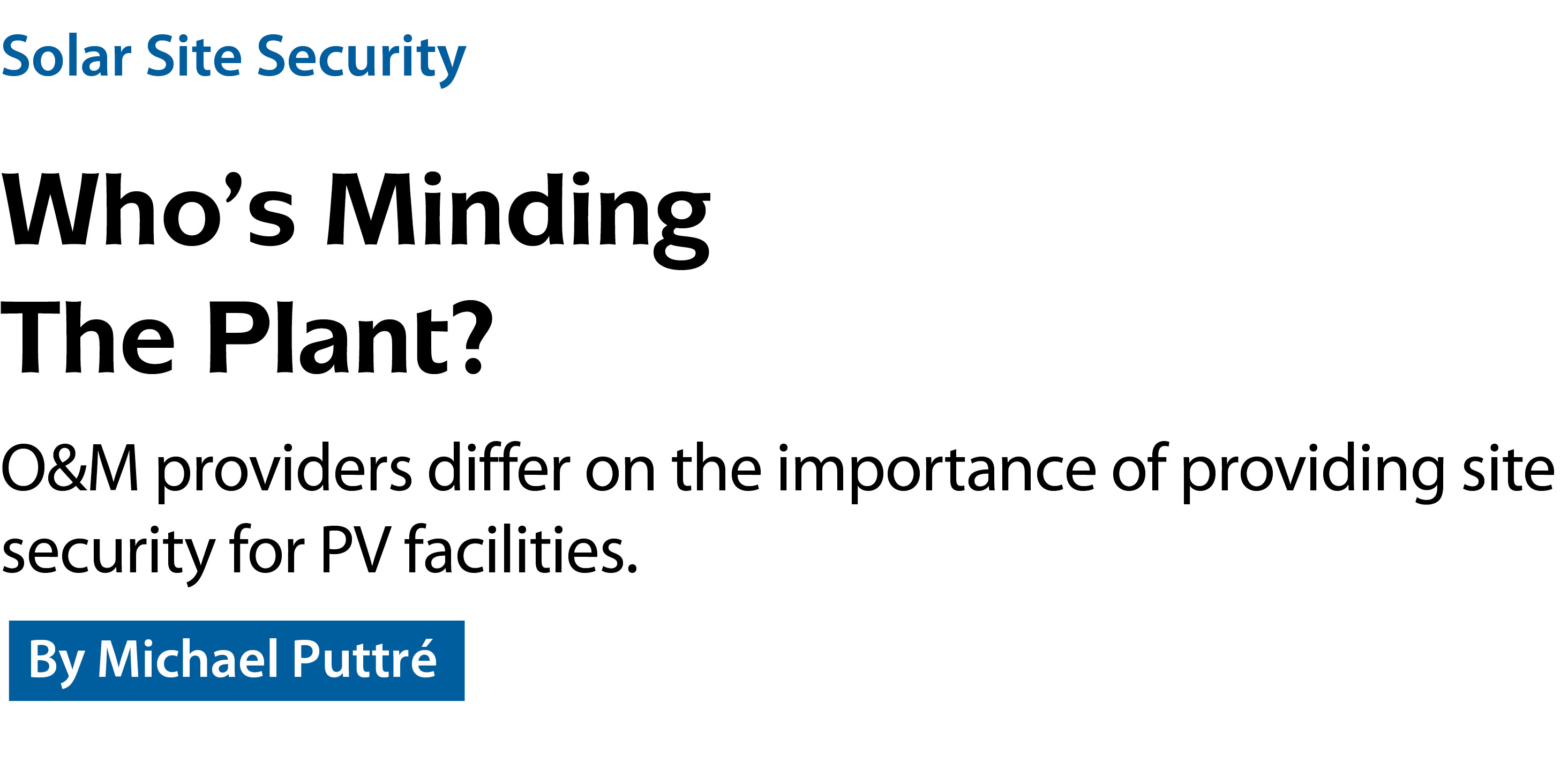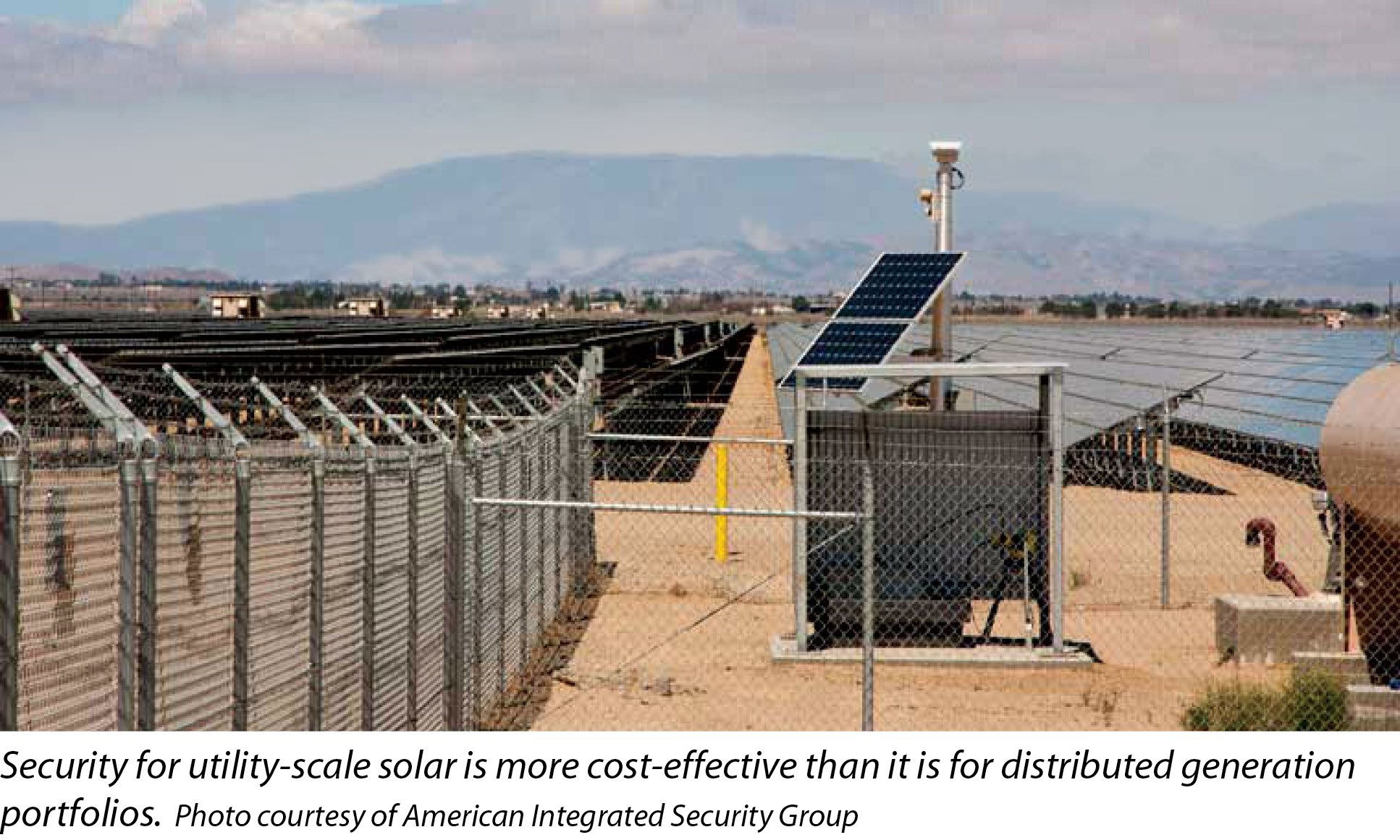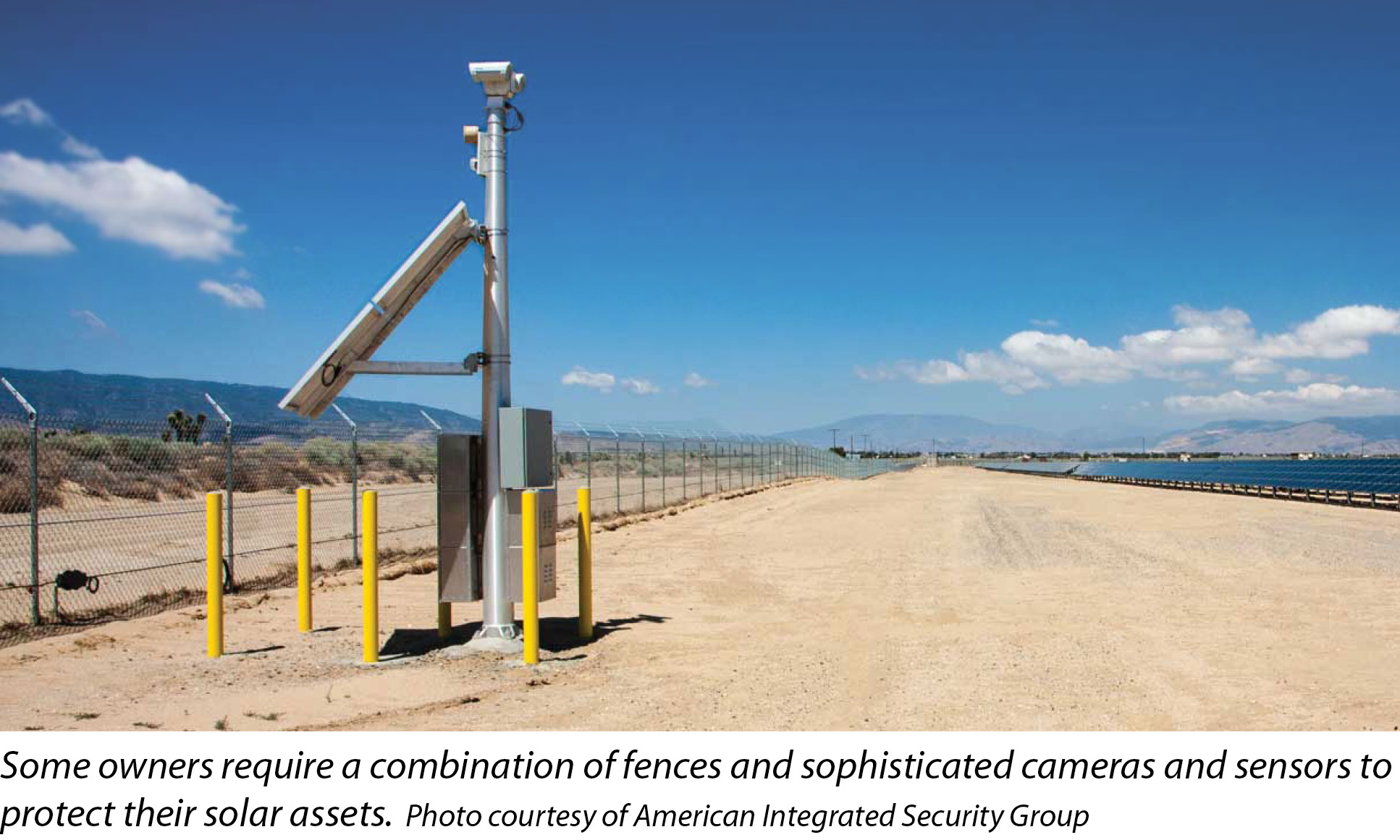

301 Moved Permanently
The operations and maintenance (O&M) services market for the solar sector is growing along with the boom in installed capacity. The lucrative field, with its promise of recurring revenue streams, is attracting solar developers and builders, as well as contractors from a variety of industries.
O&M providers must consider the role of site security for the plants they manage. Photovoltaic plants operate largely unattended. Jason Case, director of O&M for New York-based EnterSolar, says PV solar plants present a unique challenge with regard to site security compared to other types of facilities. For example, perimeter security is the primary focus for ground-mounted arrays. However, this may not apply to many roof-mounted systems where the building itself conceals much of the system and provides a level of security. Also, systems on commercial properties may be less vulnerable than other system types because the commercial hosts have an existing security plan in place for their facilities, which helps prevent security breaches involving the PV system.
“Ground-mounted solar plants are often in isolated locations and can span large areas,” Case says. “The fact that they are mostly unattended forces O&M providers and asset managers to rely on remote supervision, which can be challenging. As a result, it is imperative that cost-effective deterrence measures on the site are used in order to minimize potential risks.”
Security at a cost
The isolation of many solar sites is one reason they may be perceived as vulnerable. Laks M. Sampath, manager of U.S. and Latin America for global O&M provider Alectris in San Francisco, says utility-scale plants, in particular, pose a security challenge because of their locations. The components of a PV plant may be seen as ripe for the picking.
“Back when solar module prices were high, module theft was common because they were easy to remove,” Sampath says. “Wiring and DC component thefts keep pace with the rise and fall of copper prices. Inverters are the least likely solar components to be stolen.”
The theft problem, at least with regard to solar panels, has eased with the decline in prices and the development of more secure mounting systems. Jens Kahnert, managing director of Conergy Services in Hamburg, Germany, says that although panels remain objects of interest for thieves, demounting them has become more difficult. Also, panels typically have serial numbers and, thus, are more difficult to resell.
Then, there is the fact that a solar site is a power plant. People generally don’t understand electrical systems and are scared of electricity. So the plant itself has a deterrent value.

“Most components aren’t stolen because they are too heavy or under voltage,” Kahnert says. “We have had some stolen cables, but that is mostly in the construction phase.”
EnterSolar’s Case says that, typically, items are more likely to be stolen during the construction phase than during operation. Modules, wire, cable, conduit, aluminum racking, combiner boxes and tools are all vulnerable to theft if not properly secured and monitored.
“These problems are not unique to PV installation sites,” Case says. “However, the isolated nature of some PV sites may provide increased opportunity for thieves.”
Matt Murphy, director of O&M for Borrego Solar in Lowell, Mass., says that, by and large, operating PV plants are not tempting targets for thieves who know what they are after. Solar technology does not have enough components or materials that are worth stealing. Even scrap scavengers do not have much to gain from trying to strip a plant. True, there are a number of valuable materials in a PV module, including silver, copper and rare earth metals. However, the cost of extracting these materials is greater than their value.
“The solar panel itself is not really worth anything,” Murphy says. “People are having trouble right now trying to figure out how much it is going to cost to salvage panels at the end of their useful lives. Right now, if you want somebody to salvage your solar panels, you are paying them to do it. It’s not like typical salvage where people will come in and take it all away for you because they can make some money on the scrap.”
In Murphy’s experience, security for solar assets is not generally a high priority for owners. Of the 200 MW of solar Borrego has under management, only about 30 MW are equipped with active site security.
Around the perimeter of the actively protected sites are motion-sensor cameras that are all connected to the Internet. If motion is detected, the camera turns on, starts recording and reports to a central database. Somebody in that monitoring center is looking at the feed from the camera and determines whether there is an issue. There are subcontracted security companies that will dispatch to a site if called for.
Though robust, such active security measures for a PV plant are also atypical. Murphy says the well-protected sites are for a small customer who has assets all over the country. The owner’s inability to physically visit its assets on a regular basis prompts the desire for extensive visual monitoring from a central location.
Similarly, Solesa, an Italy-based builder and operator of solar power plants, installed a security system for its Ternavasso project in Poirino, Italy. Because the project is located over 45 minutes away from company headquarters, and 30 minutes from the nearest police station, Solesa decided to install a remotely operated security system based on thermal, high-resolution and dome cameras at key points, all connected via the Internet to a control center.
The Ternavasso facility was situated in a region surrounded by agricultural activities and wildlife. The security system uses software-based recognition algorithms to differentiate between animals and people. This was implemented to reduce false alarms.
Alectris’ Sampath says his company also uses technology to distinguish between animal activity and potential human trespassing at a remote solar site. The costs of security systems are, in general, amortized over the entire plant. “Security for a utility-scale plant is very cost-effective and starting to become a requirement because it tends to reduce insurance costs,” he says.
Conergy’s Kahnert says the importance of PV security is increasing in Germany, Spain and Italy because insurance companies are noticing that plants without video monitoring are incurring high loss and damages caused by theft.
However, providing security for portfolios of smaller plants poses a cost/benefit dilemma. Kahnert says that on the one hand, security requirements are rising due to large portfolios and more risk-averse investors. On the other hand, as long as periodic thefts are not affecting energy output, they do not affect investors in a significant way.
“From an O&M perspective, large portfolios, in general, present greater security challenges because more locations equals more risk,” says EnterSolar’s Case. “However, it really depends on the system type and location. A portfolio of ground-mounted systems could pose more challenges than a similar-size portfolio of smaller commercial roof-mounted systems. It’s really a case-by-case basis, which is why a comprehensive risk analysis must be performed for every site. There is no one-size-fits-all when it comes to security.”

The cost-effectiveness of various security technologies is regionally determined. Although thermal cameras and closed-circuit television (CCTV) systems are fairly common in the West, they are significantly less available in the developing world, where many up-and-coming solar markets are located.
“In the Philippines, it is not standard to install CCTV cameras, but rather to have a guard with a dog, which is much cheaper,” Kahnert says.
Borrego’s Murphy says that, for the most part, the U.S. owners his firm works with are not interested in spending the money to make sure that the sites are secure. “It’s an interesting paradigm in the industry because most security systems for solar that are reasonably affordable are not proactive,” he says. “The systems are not going to catch somebody in the act of stealing something and stop them. If you want better security than that, it is considerably more expensive. Owners typically are very skeptical about the value of such systems. Do I want a Cadillac system so my stuff isn’t stolen from the site, or is it enough to be insured and hope that I don’t have a really significant event?”
The O&M provider does have responsibility for looking after the security system and interfacing with the security company. If the security company calls and says it has spotted something on a motion detector, the O&M provider may be the one that will make the decision to dispatch security personnel to the site or not.
Also, O&M providers do have some responsibility for maintaining the security system. There will be maintenance procedures, such as making sure that cameras have clean lenses and are angled correctly and ensuring that the electrical wiring is in good repair.
Solar scarecrows
As indicated previously, theft is not the foremost concern of solar plant owners. Vandalism presents a more common problem. EnterSolar’s Case says vandalism of modules, including from rocks or other projectiles, is the most common post-construction risk, particularly in locations where the modules are isolated yet visible.
“People will hit golf balls into a site,” Murphy says. “Kids dirt bike around utility easements with solar sites on them. We get kids that like to drink beer and smoke on landfill sites.”
The good news here is that although they are more common than thieves, vandals are more likely to be deterred by more moderate security measures. Murphy says his favored response to such threats is what he calls “soft security.”
Examples of soft security include getting the owner to put up numerous signs claiming the area is under 24-hour surveillance. Solar sites in remote areas are good candidates for audio alarm systems, in which motion sensors trigger alarms and a recorded announcement claims responders are on the way. None of this has to be true.
“We’ve had people do soft security to the point of installing security camera domes with nothing in them,” Murphy says. “Once you start installing those domes, especially if you install a lot of them, this typically will eliminate any unwanted people on-site.”
Believe it or not, Murphy adds, soft security is highly effective at reducing the amount of damage on a site due to vandalism. “Just enough to make someone think about it and say, ‘No, this isn’t worth it.’”
Solar Site Security
Who’s Minding The Plant?
By Michael Puttré
O&M providers differ on the importance of providing site security for PV facilities.
si body si body i si body bi si body b
si depbio
- si bullets
si sh
si subhead
pullquote
si first graph
si sh no rule
si last graph